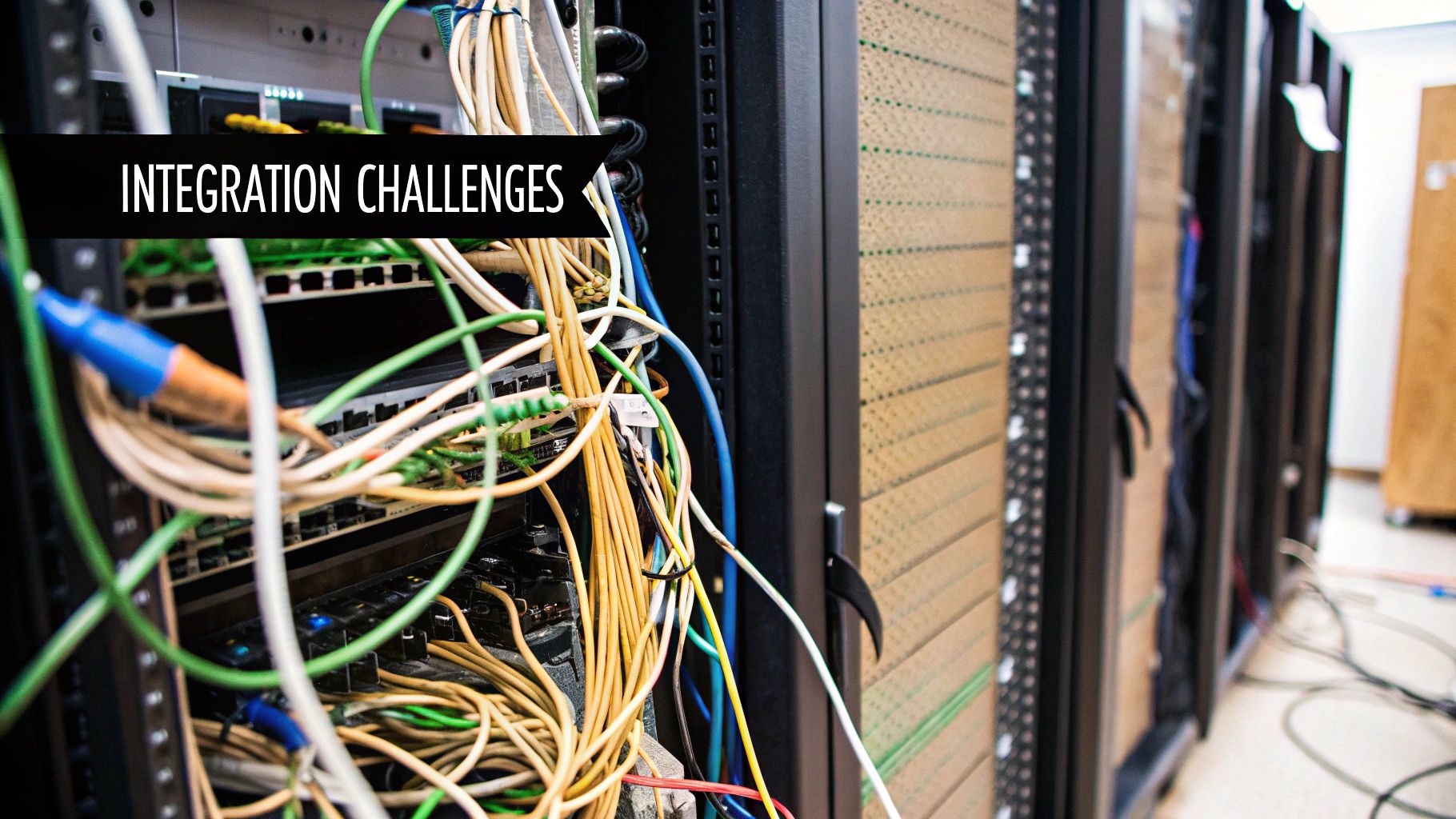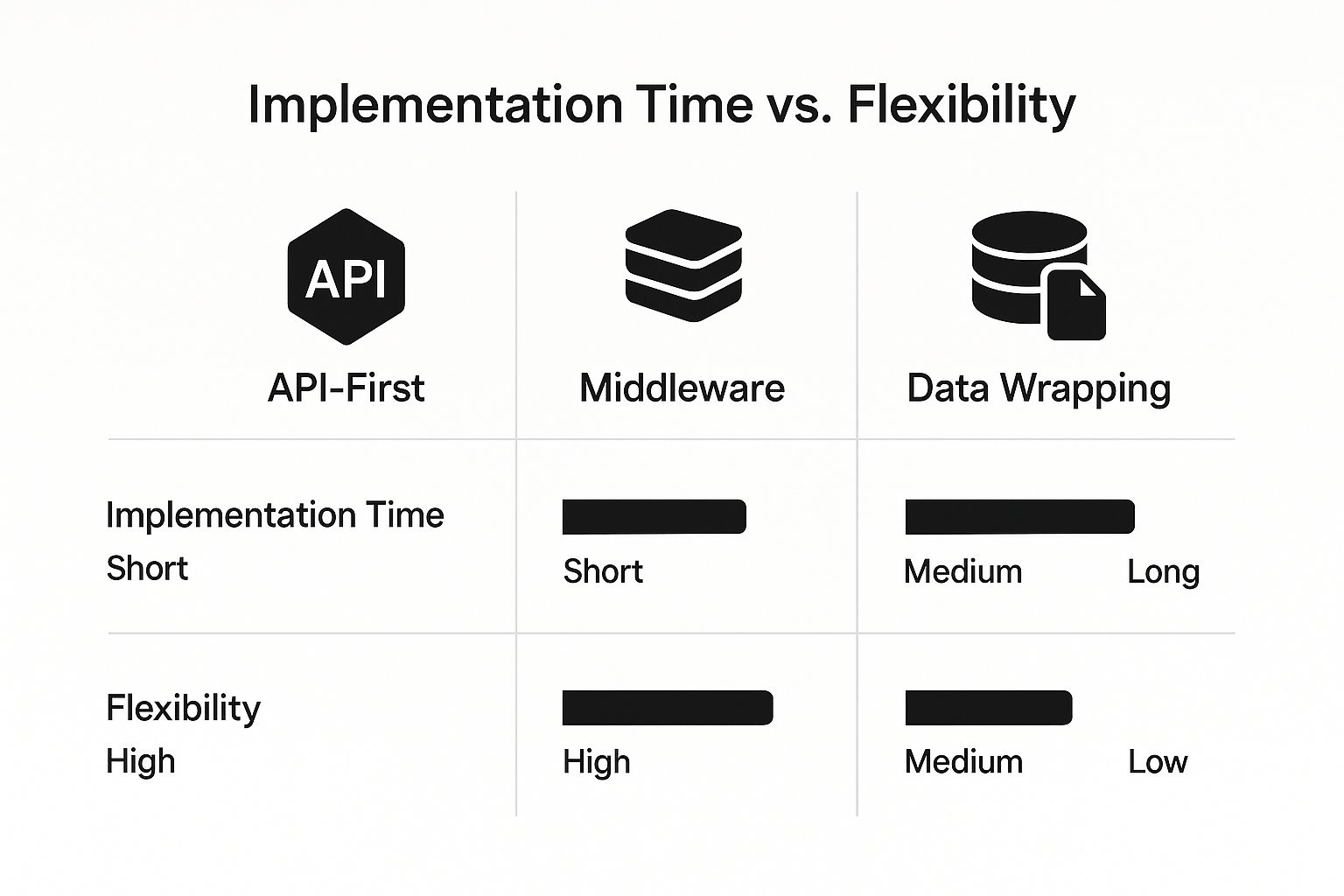Legacy System Integration: Your Complete Modernization Guide
- Matthew Amann
- May 27
- 12 min read
Understanding Legacy System Integration Fundamentals
Legacy system integration is the process of connecting older technology systems with newer ones. This allows businesses to keep the functionality of their original systems while taking advantage of modern technology. Think of it like updating a classic car with a modern engine: you want the benefits of the new engine, but it needs to work with the existing car parts. Legacy system integration bridges this gap, creating a more unified and effective overall system. This process can be complex and requires careful planning.
Core Concepts in Legacy System Integration
Understanding the different integration approaches is the first step. Budget, timeline, and the specific systems involved all play a role in deciding which method is best. Integration methods range from simple point-to-point connections to more complex solutions like an Enterprise Service Bus (ESB). Choosing the right method is crucial for minimizing disruptions and maximizing ROI.
A point-to-point integration might work for connecting two specific systems. However, for integrating multiple systems with different data formats and communication protocols, a more robust ESB is often needed.
The growth of the system integration market emphasizes the importance of these services. The market, valued at $435.9 billion in 2024, is projected to grow at a CAGR of 10% between 2025 and 2034. Some projections estimate the market will reach $1,116.68 billion by 2033. This growth shows the increasing need to integrate legacy systems with newer technologies like cloud computing and IoT devices. This need spans various industries including IT & Telecom, Defense & Security, and Healthcare. For more detailed statistics, see this System Integration Market Report. This market growth makes it clear how vital legacy system integration is for businesses wanting to stay competitive.
To further illustrate the growth across various industries, let's examine the following table:
Legacy System Integration Market Growth by Industry This table provides market size and growth projections for legacy system integration across key industries.
Industry | Market Value 2024 | Projected Growth Rate | Key Integration Drivers |
|---|---|---|---|
IT & Telecom | $XXX Billion | XX% | Cloud adoption, 5G integration |
Defense & Security | $YYY Billion | YY% | Cybersecurity modernization, real-time data analysis |
Healthcare | $ZZZ Billion | ZZ% | Electronic Health Records (EHR) interoperability, telehealth expansion |
Note: The table above represents illustrative data and would need to be populated with actual figures from market research.
As shown in the table, key drivers in each sector fuel the need for integration. From cloud adoption in IT & Telecom to EHR interoperability in Healthcare, these factors showcase the diverse applications and resulting market growth.
Key Challenges in Legacy System Integration
Legacy system integration has its challenges. Data silos, where data is isolated in legacy systems, are a common issue. This makes it difficult to share data efficiently across an organization. Another challenge is the often-limited documentation for older systems. This makes it hard to understand these systems and how they connect with other components, often leading to unexpected problems and integration delays.
Successfully navigating these challenges requires in-depth knowledge of both the older and modern systems. A well-defined integration strategy is also essential. This goes beyond just the technical side and includes the human element. Teams need the right skills and must be prepared for the changes that come with integration. Addressing these aspects ensures a smoother transition and maximizes the advantages of modernized systems.
Why Everyone's Racing To Modernize Legacy Systems Now

The business landscape is dynamic. Organizations are increasingly prioritizing legacy system integration to maintain their competitive edge. This shift is fueled by market demands for digital agility and the need to meet evolving customer expectations for seamless experiences. Businesses that fail to modernize risk falling behind.
The Urgency of Now: Why Modernization Can't Wait
Companies that delayed modernizing their systems often struggle to compete with those who embraced change. This can lead to decreased efficiency, lost market share, and challenges in attracting and retaining customers. Conversely, businesses that proactively integrated their legacy systems are experiencing significant advantages.
The rise of cloud computing, evolving regulations, and persistent security threats further underscore the urgency. These factors influence integration timelines, making delays increasingly costly. Modernization provides a competitive advantage by optimizing operations, strengthening security, and boosting customer satisfaction.
This makes legacy modernization a critical business imperative. Forward-thinking organizations are transforming their legacy systems from potential liabilities into valuable assets, unlocking new avenues for growth and innovation. Legacy system integration is a core element of this transformation. It plays a key role within the larger system integration market, which is experiencing substantial growth. For deeper insights, explore the detailed statistics here. Projections indicate this market will reach $442.53 billion by 2025 and grow to $932.66 billion by 2032, highlighting the increasing importance of connecting legacy and modern technologies.
Emerging Technologies: Making Integration More Accessible
Emerging technologies are driving the acceleration of legacy system integration, making it more accessible and cost-effective. Solutions like APIs, microservices, and cloud-based integration platforms provide new opportunities for connecting diverse systems. These technologies offer flexibility, scalability, and improved security, allowing businesses to integrate legacy systems without disrupting core operations. For further reading, consider: Top 8 Data Integration Challenges to Conquer in 2025.
Recognizing the Warning Signs: When Inaction Becomes Costly
Several key warning signs indicate when organizations can no longer afford to delay modernization:
Difficulty Meeting Customer Demands: Struggling to provide the seamless, real-time experiences customers now expect.
Increasing Maintenance Costs: Spending more on maintaining outdated systems than on modernizing them.
Security Vulnerabilities: Facing growing security risks due to outdated systems.
Lack of Agility: Unable to adapt quickly to changing market conditions.
If these resonate, legacy system integration should be a top priority. The benefits of modernization significantly outweigh the costs of inaction, ensuring long-term success and sustainability in today's evolving business environment.
Choosing The Right Integration Strategy For Your Business
Integrating legacy systems isn't a one-size-fits-all process. Choosing the wrong strategy can waste valuable time and resources. Understanding the decision-making processes used by successful organizations is key. This section will guide you through choosing the best approach for your specific business needs, from basic point-to-point connections to enterprise-wide middleware solutions.
Evaluating Integration Options Based on Business Needs
Evaluating your options begins with understanding your limitations and long-term goals. Budget constraints and project timelines are important. However, aligning your integration strategy with your overall business objectives is equally critical. This involves considering the potential impact on various departments and how the integration will facilitate future growth. You might be interested in: How to master the data integration process for better insights.
A short-term, point-to-point integration might solve an immediate issue, but it might not be scalable. Conversely, a more comprehensive middleware solution offers greater flexibility and scalability, but requires a larger initial investment. Balancing immediate needs with future adaptability is essential for maximizing ROI.
Understanding Different Integration Approaches
Several integration strategies exist, each with its own advantages and disadvantages:
API-First: Creating an API layer on top of your legacy system allows for simpler integration with other applications. This approach offers high flexibility and scalability, but may require significant development time.
Middleware: This software acts as a bridge between different systems, translating data and enabling communication between disparate applications. Middleware solutions are versatile but can be complex to set up.
Data Wrapping: This method involves creating a virtual layer around your legacy system, exposing data and functionality without altering the underlying code. Data wrapping is generally quicker to implement, but offers less flexibility.
The infographic below visualizes the implementation time and flexibility of these three approaches.

As the infographic shows, API-first integration provides the highest flexibility but requires the longest implementation time. Data wrapping is the fastest to implement but offers the least flexibility, while middleware represents a compromise between the two. Choosing the right method involves carefully weighing the trade-offs between time and flexibility.
To further clarify these differences, let's examine a comparison table:
The following table, "Legacy System Integration Approaches Comparison", compares different integration methodologies, highlighting their pros, cons, and ideal use cases.
Integration Approach | Implementation Complexity | Cost Range | Best Use Cases | Risk Level |
|---|---|---|---|---|
API-First | High | High | Integrating with multiple modern systems; long-term scalability | Medium |
Middleware | Medium | Medium | Connecting disparate systems with complex data transformations | Medium |
Data Wrapping | Low | Low | Short-term solutions; accessing limited legacy system functionality | Low |
This table summarizes the key characteristics of each integration approach. API-first offers the greatest flexibility but demands more resources. Data wrapping is the quickest and least expensive option, but is less adaptable. Middleware sits in between, providing a balance of flexibility and cost-effectiveness.
Building Cross-Functional Teams For Successful Integration
Successful legacy system integration requires more than just technology. It necessitates a team that understands both the legacy and modern systems. Building a cross-functional team with experts from different departments is essential. These teams can effectively navigate the intricacies of integration and ensure alignment with business goals.
Furthermore, promoting collaboration and communication within the team is vital for successful project execution. This unified approach addresses both technical and organizational hurdles, streamlining the integration process.
Leveraging Cloud Technologies For Seamless Integration
Cloud integration is changing how businesses connect their older systems with modern applications. Success, however, hinges on understanding effective approaches. This section explores how leading companies use hybrid cloud models to connect on-premises legacy systems with cloud-native solutions without compromising security or performance.
Modernizing Legacy Systems With Cloud Technology
Real-world examples demonstrate how microservices architectures and containerization strategies increase the flexibility and scalability of legacy systems. Microservices break down complex applications into smaller, independent services. Containerization packages these services for consistent deployment across various environments. Choosing the right approach requires a solid understanding of available integration technologies. A helpful resource is Integration Technologies: Navigating The Landscape Of Application And Data Integration.
This allows organizations to modernize legacy systems incrementally, reducing risk and enabling faster adoption of new technologies. Cloud platforms offer tools and services that simplify integration, such as pre-built connectors and data migration tools.
Security and Compliance In Cloud Integration
Security is paramount when integrating legacy systems with the cloud. We'll examine crucial security considerations for maintaining compliance during cloud integration. Robust access control mechanisms, data encryption, and regular security audits are essential for risk mitigation.
The system integration market is growing, driven by the need for cloud integration and increasing IT complexity. In 2025, market revenue topped $590.09 billion and is projected to reach approximately $1,704.65 billion by 2033, with a CAGR of 14.18%. More detailed statistics are available here. This highlights the increasing need to connect legacy systems with modern cloud solutions for better operational agility and cybersecurity.

Furthermore, integrating IT and OT systems, particularly in critical infrastructure, is becoming more prevalent. By 2024, 67% of these sectors had adopted integrated approaches, enabling them to respond 40% faster to security threats.
Cost Optimization and Performance Monitoring
Cloud integration offers substantial cost optimization opportunities. Businesses can reduce IT infrastructure costs by leveraging on-demand cloud resources. We'll explore cost-effective strategies and performance monitoring techniques for efficient operation. Real-time monitoring and performance analysis tools allow organizations to identify and address bottlenecks, ensuring optimal performance.
Architecting cloud integration for future growth is crucial. Scalability, flexibility, and maintainability are key design considerations. A modular approach and best practices allow organizations to build adaptable systems that support long-term success. This ensures your legacy system integration addresses current challenges while positioning your business for future growth and innovation.
Solving The Problems Everyone Faces But Nobody Talks About
Legacy system integration projects often encounter similar roadblocks. Let's address these common challenges, from data inconsistencies to stakeholder pushback, and explore practical solutions based on insights from seasoned project managers. Understanding available Integrations is critical for connecting legacy systems with cloud technologies.
Data Compatibility: Making Different Systems Speak the Same Language
One of the biggest hurdles in legacy system integration is data incompatibility. Older systems frequently use outdated formats that clash with modern applications. This can result in data loss, errors, and significant project delays.
Data Transformation Tools: Using tools designed for data transformation can translate data between various formats, ensuring smooth transfers.
Data Mapping: Meticulously mapping data fields between systems is crucial for accurate data migration and integration, ensuring information flows correctly.
These strategies help establish a consistent data flow, minimizing errors and maximizing the value of your integrated systems.
Security Vulnerabilities: Protecting Your Systems During Integration
Integrating older systems with modern platforms can create security vulnerabilities. Legacy systems were often built with weaker security standards, potentially creating entry points for cyber threats.
Security Audits: Conducting thorough security audits of both legacy and modern systems before integration pinpoints potential weaknesses and informs mitigation strategies.
Modern Security Protocols: Implementing updated security protocols, such as multi-factor authentication and encryption, helps protect your systems from current threats.
Proactively addressing security concerns is vital for protecting your data and maintaining business continuity during the integration process.
Performance Issues: Keeping Your Systems Running Smoothly
Performance issues can plague legacy system integrations, leading to user frustration and impacting business operations. Bottlenecks can arise from system incompatibilities, inefficient data transfer, or inadequate infrastructure.
Performance Monitoring: Consistently monitoring system performance during and after integration helps identify and address bottlenecks quickly.
Load Testing: Simulating real-world usage through load testing helps determine how the integrated system handles peak traffic, ensuring optimal performance under pressure.
These methods ensure integrated systems operate efficiently and meet user expectations and business needs.
Managing Vendor Relationships and Licensing: Navigating the Complexities
Integrating legacy systems often involves multiple vendors with various contracts and licensing agreements. This can create complexities, especially when troubleshooting.
Clear Communication: Establishing clear communication with all involved vendors ensures everyone understands the project and can collaboratively address issues.
Contract Review: Carefully reviewing all vendor contracts and licensing agreements clarifies the terms related to integration and support.
Proactive vendor relationship management prevents costly delays and disputes. It also streamlines problem-solving, leading to a more efficient and collaborative integration process.
Maintaining System Uptime: Minimizing Disruptions During Integration
Maintaining system uptime during integration is essential for minimizing business disruption. Downtime can cause lost productivity, customer dissatisfaction, and financial losses.
Phased Rollouts: Implementing the integration in stages, instead of all at once, reduces the impact on daily operations.
Thorough Testing: Rigorous testing before each phase verifies the integrated systems’ functionality and reduces the risk of unexpected problems.
This measured approach allows you to maintain business operations while transitioning to the upgraded, integrated system. It also provides opportunities to address potential issues early, minimizing the risk of major disruptions.
Measuring Success And Optimizing Your Integration Results

How can you tell if your legacy system integration is truly effective? While uptime and performance are essential technical considerations, it's crucial to understand the metrics that resonate with business stakeholders and end-users. This means shifting the focus from purely technical measurements to tangible business outcomes. This section explores how to measure success and optimize your integration for lasting value.
Establishing Meaningful Baselines and Tracking Progress
Before you begin the integration process, establish clear baselines for your key performance indicators (KPIs). These baselines serve as a benchmark to measure the integration's impact. Track metrics such as order processing time, customer service response times, and data entry errors. This provides a crucial starting point for evaluating improvements.
After integration, regularly monitor these KPIs to track progress and identify areas for optimization. This ongoing monitoring allows you to showcase the integration's value to stakeholders and justify future investments in modernization efforts.
Building Monitoring Systems That Provide Actionable Insights
Effective monitoring involves more than visually appealing dashboards. It's about collecting data that offers actionable insights into system performance and user experience. Track API call volumes, error rates, and data transfer speeds, for example. This data helps pinpoint bottlenecks and identify areas for improvement.
By focusing on data that directly impacts business operations, you can proactively address potential issues and ensure the integrated system delivers real value.
Creating Feedback Loops for Rapid Problem Resolution
Establish clear feedback loops between IT teams, business users, and stakeholders. This facilitates the rapid identification and resolution of any arising problems. Implement a system for users to report issues and provide feedback on the integrated system.
Regular communication with stakeholders ensures alignment between IT efforts and business objectives. This collaborative approach allows for swift and efficient problem resolution.
Performance Tuning and Ongoing System Health Assessment
Continuously tune the integrated system to maintain optimal performance and address emerging issues. This might involve optimizing database queries, streamlining data flows, or upgrading hardware. Regular system health assessments help identify potential risks and inform capacity planning decisions.
This proactive approach prevents small issues from escalating into major problems and supports long-term business growth. Much like a well-maintained car performs better over time, consistent attention keeps your integrated systems running smoothly. Consider partnering with a firm like Flow Genius for expert assistance in optimizing your integration results and ensuring long-term success. Their customized workflows and data advisory services can transform your raw data into actionable insights, empowering you to make informed decisions and stay ahead of the curve.
Building Integration Solutions That Stand The Test Of Time
The technology world changes quickly. This means your legacy system integration solution must be adaptable and ready for the future. This section explores how to design integrations that evolve and avoid becoming technical debt. We'll discuss balancing current needs with future flexibility, using insights from experienced architects.
Designing for Adaptability: Principles for Long-Term Success
Building a sustainable integration solution requires forward thinking. Consider these key principles:
Modularity: Design your integration using modular components. This allows for easier updates and modifications without a complete system rebuild. Think of it like building with LEGOs – change parts without dismantling everything.
Open Standards: Prioritize open standards and APIs for maximum interoperability. This simplifies connecting with new systems and technologies as they emerge.
Abstraction: Create abstraction layers between systems. This protects your integration from the complexities of individual systems, making it more resilient to changes.
These architectural principles create a foundation for long-term stability and adaptability.
Embracing Emerging Technologies: Preparing for the Future of Integration
Emerging technologies, like AI and automation, are transforming integration possibilities. Check out our guide on Unleashing the Power of Automation. While we can't predict the future, designing for flexibility is crucial. This means using an API-first approach to integration. Building a robust API layer around your legacy systems prepares you for connecting with future technologies.
Maintaining and Optimizing: Ensuring Long-Term Value
Maintaining your legacy system integration is an ongoing process. Regular system health checks and performance monitoring help identify potential issues early. A proactive maintenance plan minimizes disruptions and extends your solution's lifespan.
Stakeholder engagement is also vital. Regular communication and feedback from business users ensures the integration continues meeting their needs. This ongoing dialogue maintains relevance and ensures continued support for your modernization vision.
Strategic Planning for Future Integrations: Staying Ahead of the Curve
A long-term strategic plan is essential for keeping your integration solution relevant. This involves regularly evaluating your integration strategy, considering new technologies and changing business needs. By staying informed about industry trends and anticipating future requirements, you can avoid costly reworks and ensure your integration strategy supports your organization's goals. This proactive approach ensures your legacy system integration remains valuable as technology evolves.
Ready to transform your business with smart automation? Contact Flow Genius today to learn how we can streamline your operations, integrate legacy systems, and unlock new levels of efficiency.